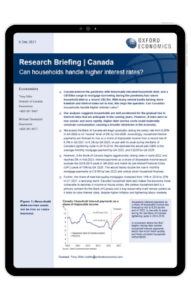Can Canadian households handle higher interest rates?

Canada entered the pandemic with historically elevated household debt, and a C$193bn surge in mortgage borrowing during the pandemic has raised household debt to a record C$2.5tn. With many central banks turning more hawkish and interest rates set to rise, this begs the question: Can Canadian households handle higher interest rates?
What you will learn:
- Our analysis suggests households are well positioned for the gradual rise in interest rates that we anticipate in the coming years.
- We expect the Bank of Canada will begin gradually raising the policy rate from 0.25% in Q4 2022 to its “neutral” level of 2% by mid-2026.
- However, if the Bank of Canada begins aggressively raising rates in early-2022 and reaches 2% in mid-2023, interest payments as a share of disposable income would surpass the 2018-2019 peak in Q4 2022 and match its pre Global Financial Crisis (GFC) peak of 10% by Q4 2026.
Tags:
Related Services

Post
Nowcast shows wage growth slowing sharply
Our sentiment data, developed with Penta, suggests that UK private sector wage growth slowed sharply in March and early-April. If official data mirrors our sentiment indicator, it should keep the Monetary Policy Committee on track to cut interest rates in the summer.
Find Out More
Post
The euro and depreciation – shake, shake it off
Our new forecast assumes a slower euro appreciation against the dollar over the coming years than we previously anticipated. Relative productivity, terms of trade, and the current account will likely be less supportive of the euro than we thought. In addition, a stronger stock market than initially envisaged will attract more financial flows into the US than we had expected.
Find Out More